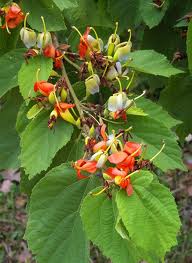| PlantID | 0104 |
| Botanical Name | Helicteres isora |
| Common Name | Marodphali |
| Classification | | Kingdom: | Plantae | | Subkingdom: | Tracheobionta | | Division: | Magnoliophyta | | Class: | Magnoliopsida | | Subclass: | Rosidae | | Order: | Malvales | | Family: | Malvaceae | | Genus: | Helicteres | | Species: | isora |
|
| Part used | Fruits, seeds, bark, and root. |
| Medicinal Properties | Fruits: astringent; root: astringent, demulcent, diuretic and antigalactogogue. |
| Medicinal Use | Fruits: useful in colic, griping pain in the bowels and flatulence; seeds: in otorrhea used with pure castor oil; bark: diarrhoea and dysentery; root: useful in diarrhoea, dysentery, griping pain in bowels, flatulence and in diabetes. |
| Chemistry | Bark: chloroplast pigments, phytosterol, hydroxy-carboxylic acid, saponins and lignin; fruits: alpha and beta amyrins, lupeol and taraxerone; seed: diosgenin. |
| Cultivation | NA |
| Regional Habitat | Throughout Rajasthan in dry forests as undergrowth. |
| Description | A large shrub or small tree upto 5m in height. Bark grey, covered with stellate hairs in young parts. Leaves simple, alternate, bifarious, obovate. Flowers red, solitary or in sparse clusters. Fruits greenish-brown, beaked cylindrical. Seeds numerous, angular, wrinkled. |
| Image |  |


